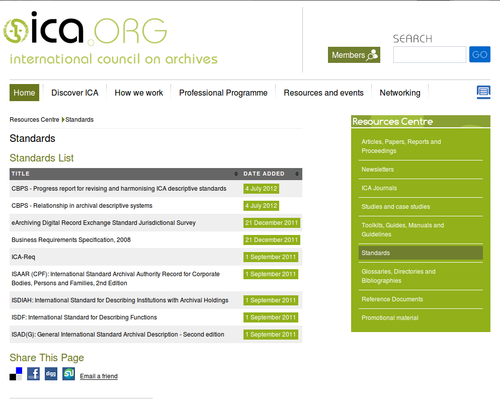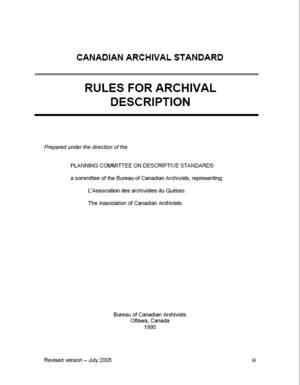Difference between revisions of "Descriptive standards"
| (6 intermediate revisions by 3 users not shown) | |||
| Line 4: | Line 4: | ||
[[Image:um1-4ICA.png|500px|right|thumb|ICA-AtoM is built around the ICA's descriptive standards]] | [[Image:um1-4ICA.png|500px|right|thumb|ICA-AtoM is built around the ICA's descriptive standards]] | ||
| − | While ICA-AtoM is designed around the [http://www.ica.org/ ICA's] international descriptive standards ([[RS-1|ISAD | + | While ICA-AtoM is designed around the [http://www.ica.org/ ICA's] international descriptive standards ([[RS-1|ISAD]], [[RS-2|ISAAR]], [[RS-3|ISDIAH]] and [[RS-4|ISDF]]), it is intended to be flexible enough to accommodate other practices based on other (national or local) descriptive standards. |
| Line 16: | Line 16: | ||
To implement support for other standards: | To implement support for other standards: | ||
| − | * Map the data elements of the target standard to the related ICA standard and - via this "metadata crosswalk" - to the underlying database architecture in ICA-AtoM/[http://qubit-toolkit.org/ Qubit] | + | * Map the data elements of the target standard to the related ICA standard and - via this "[[Crosswalks|metadata crosswalk]]" - to the underlying database architecture in ICA-AtoM/[http://qubit-toolkit.org/ Qubit] |
* Use existing ICA-AtoM fields wherever the crosswalk establishes a direct correlation between elements in the ICA and target standards | * Use existing ICA-AtoM fields wherever the crosswalk establishes a direct correlation between elements in the ICA and target standards | ||
* Create "custom fields" for all other elements in the target standard using ICA-AtoM's "property" database table (where "type" is the name of the element and "value" is the data itself) | * Create "custom fields" for all other elements in the target standard using ICA-AtoM's "property" database table (where "type" is the name of the element and "value" is the data itself) | ||
| Line 23: | Line 23: | ||
Adding support for another standard requires a [[Glossary#Developer|developer]] to work on the underlying software code. Once support has been added, however, ICA-AtoM provides an interface allowing [[Glossary#Administrator|administrators]] to easily select their preferred standard and to switch between the various standards. | Adding support for another standard requires a [[Glossary#Developer|developer]] to work on the underlying software code. Once support has been added, however, ICA-AtoM provides an interface allowing [[Glossary#Administrator|administrators]] to easily select their preferred standard and to switch between the various standards. | ||
| − | |||
== Other (non-ICA) standards currently supported == | == Other (non-ICA) standards currently supported == | ||
| Line 30: | Line 29: | ||
| − | === | + | === Rules for Archival Description (RAD) === |
[[Image:um1-4RAD.png|300px|right|thumb|Canadian Rules for Archival Description]] | [[Image:um1-4RAD.png|300px|right|thumb|Canadian Rules for Archival Description]] | ||
| − | RAD is maintained by the [http://cdncouncilarchives.ca/ Canadian Council of Archives] | + | RAD is maintained by the [http://cdncouncilarchives.ca/ Canadian Council of Archives] and is available at http://www.cdncouncilarchives.ca/archdesrules.html. RAD-specific sections of this manual are available at [[Rules for Archival Description]]. |
| Line 44: | Line 43: | ||
=== Metadata Object Description Schema (MODS) === | === Metadata Object Description Schema (MODS) === | ||
| − | The MODS standard is available at [http://www.loc.gov/standards/mods/mods-outline.html Metadata Object Description Schema (MODS)]. Currently ICA-AtoM supports the Digital Library Federation second level of adoption for MODS (see [https://wiki.dlib.indiana.edu/confluence/display/DLFAquifer/MODS+Guidelines+Levels+of+Adoption DLF Aquifer MODS Guidelines Levels of Adoption]). MODS-specific sections of this manual are available at [[MODS]] | + | The MODS standard, maintained by the US Library of Congress [http://www.loc.gov/marc/ndmso.html Network Development and MARC Standards Office], is available at [http://www.loc.gov/standards/mods/mods-outline.html Metadata Object Description Schema (MODS)]. Currently ICA-AtoM supports the Digital Library Federation second level of adoption for MODS (see [https://wiki.dlib.indiana.edu/confluence/display/DLFAquifer/MODS+Guidelines+Levels+of+Adoption DLF Aquifer MODS Guidelines Levels of Adoption]). MODS-specific sections of this manual are available at [[MODS]] |
Latest revision as of 18:07, 12 October 2012
Please note that ICA-AtoM is no longer actively supported by Artefactual Systems.
Visit https://www.accesstomemory.org for information about AtoM, the currently supported version.
Main Page > User manual > Overview > Supported descriptive standards
While ICA-AtoM is designed around the ICA's international descriptive standards (ISAD, ISAAR, ISDIAH and ISDF), it is intended to be flexible enough to accommodate other practices based on other (national or local) descriptive standards.
Support
"Support" means that users of another standard should be able to use ICA-AtoM to produce outputs that are compliant with that standard. This includes the ability to enter data in fields that represent all of the data elements required by the standard, interact with (view, edit, search) data in ways structured by and labeled according to the terms of the standard, and output (print, export) data in formats compliant with the standard.
Design principles
To implement support for other standards:
- Map the data elements of the target standard to the related ICA standard and - via this "metadata crosswalk" - to the underlying database architecture in ICA-AtoM/Qubit
- Use existing ICA-AtoM fields wherever the crosswalk establishes a direct correlation between elements in the ICA and target standards
- Create "custom fields" for all other elements in the target standard using ICA-AtoM's "property" database table (where "type" is the name of the element and "value" is the data itself)
- Create additional PHP methods for managing the data as required
- Add user interface templates (view and edit pages) using page divisions and field labels based on the structure and terminology of the target standard
Adding support for another standard requires a developer to work on the underlying software code. Once support has been added, however, ICA-AtoM provides an interface allowing administrators to easily select their preferred standard and to switch between the various standards.
Other (non-ICA) standards currently supported
Users of other descriptive standards should be aware that this manual is generally based on the ICA standards for its examples and screenshots. Standard-specific sections are noted below.
Rules for Archival Description (RAD)
RAD is maintained by the Canadian Council of Archives and is available at http://www.cdncouncilarchives.ca/archdesrules.html. RAD-specific sections of this manual are available at Rules for Archival Description.
Dublin Core Metadata Element Set, Version 1.1
ICA-AtoM implements unqualified Dublin Core Metadata Element Set, Version 1.1. Dublin Core-specific sections of this manual are available at Dublin Core.
Metadata Object Description Schema (MODS)
The MODS standard, maintained by the US Library of Congress Network Development and MARC Standards Office, is available at Metadata Object Description Schema (MODS). Currently ICA-AtoM supports the Digital Library Federation second level of adoption for MODS (see DLF Aquifer MODS Guidelines Levels of Adoption). MODS-specific sections of this manual are available at MODS

